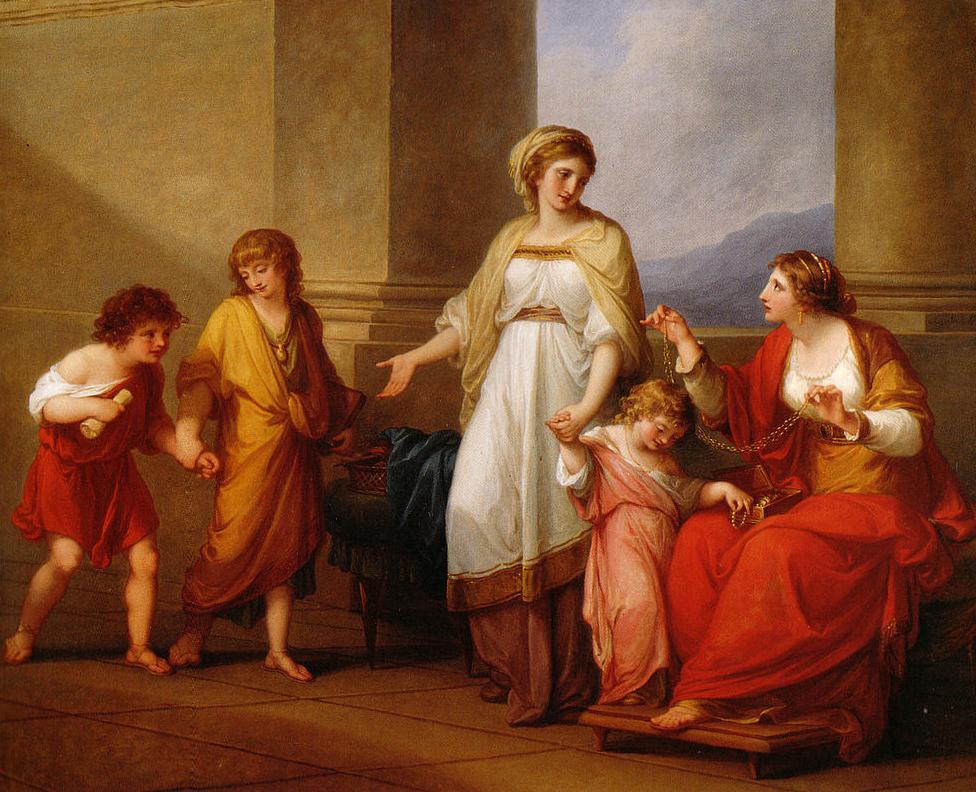
Roman Class Conflict: The Gracchi (2nd Century BC)

Figure 1.--This painting, 'Cornelia, Mother of the Gracchi' was the work of Angelica Kauffmann (1741-1807) a Swiss born female artist (1785). She with another woman artisdt were the first to be admitted to theBritish Royal Academy. The painting shows Cornelia with another Roman woman who holds a box of jewelry on her lap. Sheholds up a gold necklace to be asdmired. Cornelia in response gestures towards her two boysto indicate that they are her treasures. The painting is some times called, 'Cornelia Presenting Her Children as Her Treasures'. Sempronia, her daughter ismore impressed with the jewelry. The Gracchi were controversial figures. Cornelia in contrast was admired as an outstandingly virtous Romaan mother.
|
|
The tribunes Tiberius Gracchus tribune of the plebs and Gaius Gracchus tribune of the plebs attempted to reform the Roman social system. Cornelia Africana (195–115 BC) was the second daughter of Publius Cornelius Scipio Africanus, the hero of the Second Punic War. She married Tiberius Gracchus the Elder. Cornelia was the mother of the Gracchi brothers, Tiberius and Gaius. She was a rare Roman female hero. Her sons were very controversial, not sdo Cornelia. She was honored for her dingle minded dedication to her family. After being widowed at a relstively young age, she did not remarry although she had offers. Instead she dedicated herself to bringing up her hree surviving children. She provided Greek tutors and saw to it thst they received the best educastion popssible. Cornelia played a major role in their rise to prominance and advised them throughout their political careers. The old patrician families and the newly enobleled wealthy plebian families resisted the Gracchi reforms. They combined to exclude all others from the higher offices (magistracies) and the Senate which now cntroled state affairs. This aristocratic ruling class now dominated Rome. Its members had become fabulously wealthy from the plunder of empire, but rather than sharing with the plebian class they arrogantly devoted themselves to untold luxury and resistance to the rise of plebians and a share in the bounty of empire. The admirably high standards and honesty of the early Republic was lost. In addition the small-scale peasant farmers found themselves unable to compete with the large estates worked by slaves obtained in Rome's wars. The independent peasantry which had been the backbone of Rome was gradually being reduced to poverty, forcing them off the land and into the cities--becoming city rable, bitter and reduced to a magre living off a state dole. The Gracchi brothers attempted to reform the Roman Republic to adjust to the new empire. The conservative patrician and newly enpbeled class, however, resisted the reforms as a threat to their traditions and entrenched position. The Gracchus Brothers attempted to aleviate economic distress and pursue agraian reform and corn laws. Tiberius Gracchi were so popular with the Roman masses, that he ran for a second consecutive term for tribune which was unconstitutional. A group of conservative senators organized an armed band and attacked him in the Assembly. They killed him as well as 300 of his followers, beating them to death (133 BC). Gaius Sempronius Gracchus (Tiberius' younger brother) was elected tribune for two successive years Through the Assembly he challenged the power of conservative classes and the Senate. He also attempted the sweeping economic reforms his brother had promoted. Opposition between his followers and the Senate degenerated into street fighting and riots. He was killed in the rioting and his followers were executed by Opimius (121 BC). The sipression of the Gracchi in many ways began the decline of the Republic. Increasingly personalities began to dominate Roman politics and the major conflicts were no longer with foreign powers, but conflicts between Roman classes. Violence flared as never before in Roman life. Eventually Caesar would more efftively manage his popularity with the people. His assasinastion (44 BC) led to the end of the Republic and the principate under Augustus.
Sources
CIH

Navigate the Children in History Website:
[Return to the Main class conflict 2nd century BC page]
[Return to the Main 2nd century BC page]
[About Us]
[Introduction]
[Biographies]
[Chronology]
[Climatology]
[Clothing]
[Disease and Health]
[Economics]
[Freedom]
[Geography]
[History]
[Human Nature]
[Ideology]
[Law]
[Nationalism]
[Presidents]
[Religion]
[Royalty]
[Science]
[Social Class]
[Bibliographies]
[Contributions]
[FAQs]
[Glossaries]
[Images]
[Links]
[Registration]
[Tools]
[Children in History Home]
Navigate the Historic Boys' Clothing Web chronological pages:
[Return to the Main Roman chronology page]
[Return to the Main chronology page]
[The 6th century BC]
[The 5th century BC]
[The 4th century BC]
[The 3rd century BC]
[The 2nd century BC]
[The 1st century BC]
[The 1st century AD]
[The 2nd century AD]
[The 3rd century AD]
[The 4th century AD]
[The 5th century AD]
[The 6th century AD]
Created: 10:24 PM 1/28/2019
Last updated: 10:24 PM 1/28/2019



